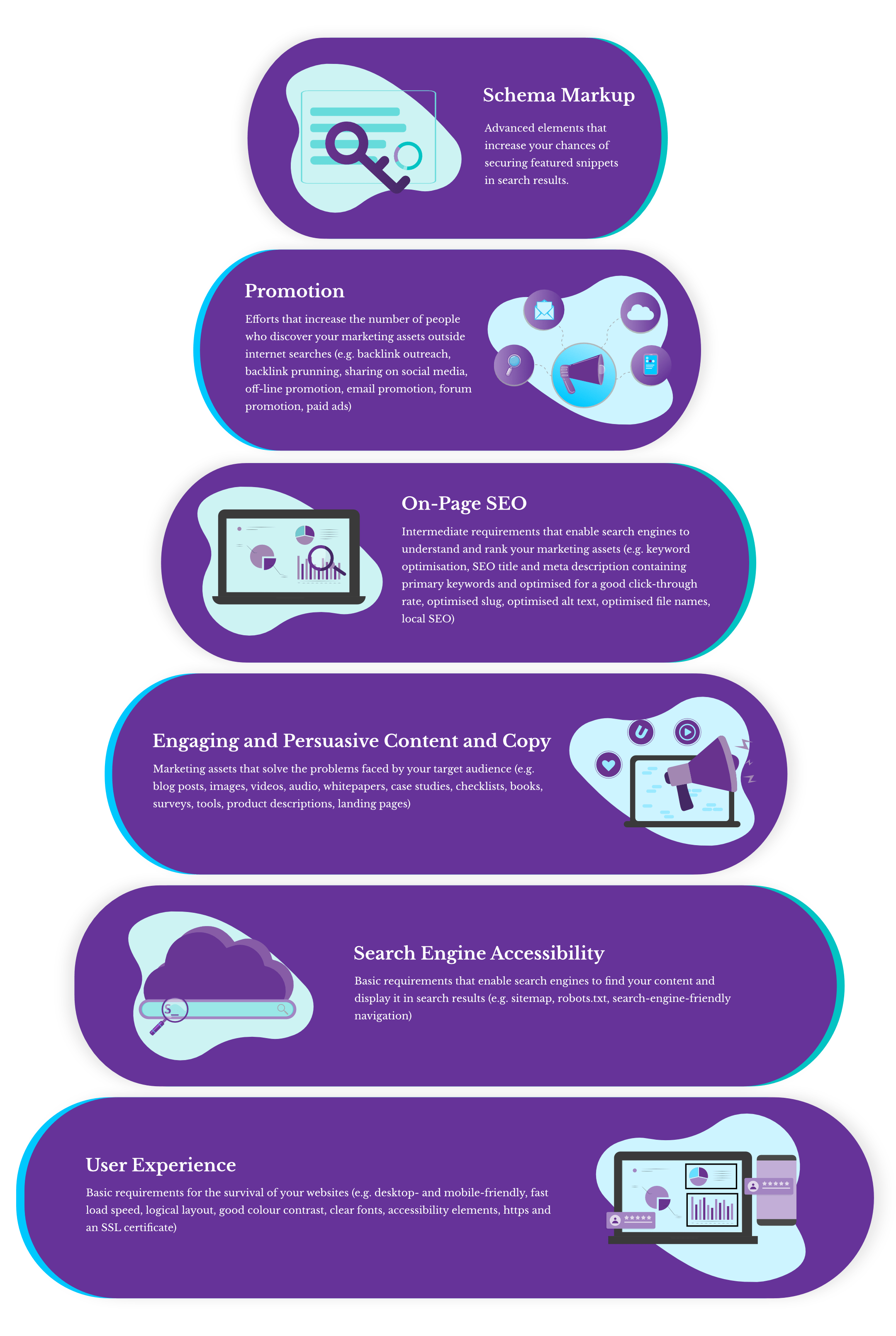The top SEO myths you need to stop believing if you want more search traffic and increased profits

Google and other search engines are, understandably, somewhat secretive about exactly how they decide where content will show up in their search results. But that’s lead to lots of myths and fallacies that will harm your profits if you believe them. So, if you want more search traffic and profits for your small business, here are the top three myths and fallacies you need to stop believing right now. Listen to the blog post audio or read on.
Topics covered
Myth 1 — If big brands are doing it, it must be good

This is the single most harmful SEO myth you can believe if you’re a small business. Far too many small businesses think, just because their big business competitors are generating great profits and have the budgets to do a great job, that they must have spent their money wisely on research, professional development, and top talent and that they must be following best practices.
It’s not true.
Big businesses often have lots of money to throw around. But that means they don’t feel as motivated to get the best value for their money. Plus, big business decision-makers aren’t as committed to the company’s success as, say, a sole trader or family-owned business, so when they’re outsourcing content creation or SEO work, they’ll do just enough work to find someone who won’t make them look bad, but they’re often not motivated to go the extra mile and find the perfect person or agency.
All of that means big businesses don’t always make the best SEO decisions.
Let me give you an example. Let’s say you have two options.
Option A: You spend $600 on a blog post that looks really good in search results and so has the potential to attract lots of people from your target market. You want to turn those visitors into customers as quickly as possible, so you demand that your writer add a clear ‘buy now’ call-to-action at the bottom of the blog post.
Option B: You spend $600 on a blog post that looks really good in search results and so has the potential to attract lots of people from your target market. You want to turn as many of those visitors as possible into customers, so you spend another $2000 to get two more blog posts that all link together and have your writer add a subtle ‘buy now’ call-to-action to the third blog post.
What do you think would happen in each situation? Well, the most likely result is that the first blog post would attract lots of visitors from the target market. In option A, those visitors would get to the bottom of the post, and many of them would roll their eyes and click away in disgust at the blatant sales pitch. Maybe 1% of readers click on the link and 15% of those people make a purchase. In option B, the visitors get to the bottom of the post, and most of them love the look of the next post in the series, so they click through to read it. And most of them do the same with the third. When they get to the end of the third blog post, 80% of the readers see the call-to-action and are intrigued, so click on the link. 20% of those people make a purchase.
So which option would you choose?
Option B costs more but results in far more sales and so results in substantially higher profits. Yet, I’ve had several big brands choose option A despite me providing data to show option B is more likely to achieve their goals. For some, they just don’t understand content marketing and aren’t willing to learn about it. For others, option B was more work, so they went with the quicker option, knowing it would at least generate some results — enough to make their bosses happy.
A big business could afford to buy all three posts at once and publish them in quick succession. As a small business, you might have to spread your three posts out over several months in order to afford them, but it’s still doable.
This is just one example of how big businesses don’t always get things right.
Now, that doesn’t mean all big businesses make poor SEO decisions. But when they do make good ones, you still shouldn’t blindly copy them. Your business is unique and your target market will be different from theirs. So what works perfectly for a big business isn’t necessarily going to be the best option for your business.
Big businesses don’t always know something you don’t. So don’t assume their way is the best when it comes to SEO.
Do this instead
Instead of assuming that big businesses are doing great SEO things, when you see an innovative approach that you think might work for your audience, test it out. It’s just like using stain remover — the instructions always say to test it on an inconspicuous area of fabric to ensure it’s not going to strip the colour or damage the material. The same goes for SEO. Test new ideas you see big businesses exploring on less important areas of your site — somewhere that’s not bringing in a significant amount of traffic, so you’re not going to take a big hit if it doesn’t work.
Myth 2 — All you need is content

Many people dipping their toes into SEO waters for the first time develop the impression that all you need to succeed with search engines is to produce lots of content. After all, ‘content is king’ right…
The thing is, you can have more content than any of your competitors combined and still never realise much search traffic or search profit let alone out rank your competitors.
Ever heard of Maslow’s hierarchy of needs? The theory states that we strive to fulfil basic physical needs before aiming to satisfy more psychological and emotional needs. For example, there’s no point trying to build a reputation as the world’s best neurosurgeon (to satisfy your esteem needs) if you’re going to die of dehydration within a couple of days (the physiological needs take precedence).
Well, striving for a large quantity of content is rather like trying to fulfil your social needs before you’ve met your physiological and safety needs. If you’re not providing a good experience for your website visitors and enabling search engines to access your website, then it doesn’t matter how much content you have, you’ll still never get far with it because no one will enjoy consuming it and search engines won’t be able to find and index it (so chances are not many people will ever see it).
Apart from that, quantity doesn’t trump quality. A small amount of excellent quality content is far more valuable and effective than lots of terrible or even mediocre content, especially if you keep that small batch of content updated. As just one example, it’s entirely possible to publish a blog post that attracts more traffic than your homepage. It’s true. I do this all the time. Here’s an example.
Content is vital if you want to succeed with SEO. But it’s not the only thing that matters.
You need this instead

Myth 3 — SEO is just about search rankings

Optimising content for search engines isn’t just about ranking well in their search results. At least it shouldn’t be. After all, showing up at the top of a page of search results means very little, other than potentially increased brand awareness, if your target market doesn’t click on your search listings and eventually take an action that results in you getting money.
So, a holistic definition of SEO states that it’s the process of:
- Optimising websites and content, so visitors get the best experience; and
- Helping search engines find web content and understand its value, so that you
- Get more web traffic that’s more relevant to your business goals; and
- Generate more profit from more sales and reduced costs
Showing up more prominently in search results (getting better rankings) means more people have the opportunity to see your search listings. This can lead to more web traffic, and that can lead to greater profits, but it doesn’t necessarily. You can improve your search rankings and not attract any additional web traffic. This is especially true if you end up in a featured snippet that answers a search query from within the browser. You can also substantially increase your volume of web traffic without increasing your profits, especially if you’re attracting the wrong kinds of people.
For greater search visibility to deliver significant benefits to your business, it must lead to more profits. Usually this happens when:
- More people from your target market visit your website, so
- More of your ideal customers see your sales messages, so
- More people buy your products or services(or click on your outbound affiliate links or the ads you host on your site), and
- The money generated by this outweighs the cost of achieving that level of search visibility
As such, SEO is absolutely not just focussed on search rankings. Anyone who tells you it is missing a huge part of the picture.
Good SEO is actually about your ideal customers

Getting better search results isn’t about pleasing search engines, it’s about pleasing humans, specifically the people you want to make money from. When you give them what they want, search engines are incentivised to show your content to those people when they perform searches.
Really, the only thing you need to do for search engines is make sure they can access your content and understand what search queries your content is relevant to.
Bearing this in mind, you’ll get the best search results if your content:
- Is displayed prominently in search results (ranks well)
- Encourages your ideal customers to click through to your website (has a high click-through rate)
- Demonstrates your subject matter expertise, so your ideal customers can see you know what you’re talking about
- Proves you can solve a problem for your ideal customers, so they know you can deliver benefits to them
- Leads your ideal customers to a sale, so you can convert search leads into customers
- Ensures your customers are thrilled with their purchase, so they come back for more and so they say nice things about your products, services and business
Achieving good search rankings is, in theory, pretty straightforward. In fact, if your content does everything above except it isn’t yet displayed prominently in search results, good search rankings will generally follow without you having to do anything else.
What to do if you’ve subscribed to these myths
If you’ve been entirely focussed on your search rankings, log in to Google Search Console and take a look at how your pages are performing. Note any that have a high number of impressions and a low click through rate and work on optimising the SEO title, meta description and slug for those pages.
Then look at your sales funnels and explore better ways of leading your visitors to a sale. That might be as simple as testing new call-to-actions on your informational content (like blog posts).

If you’ve been copying your big brand competitors, take a look at your customer personas, branding strategy and content strategy and ensure they’re all aligned. In particular they should all make sense in the context of your unique selling points, and your branding and content strategies should be aligned to the needs of your ideal customers.
Then critically analyse the SEO techniques you’ve been using to see if they’re enabling you to deliver value to your ideal customers while staying true to your branding strategy. Flag for review any practices that aren’t and you’ll be well on your way to developing an SEO strategy that meets your business’s needs.
